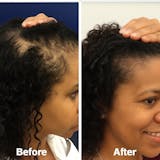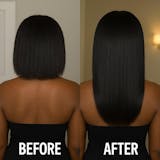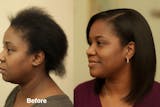Your Hair, Your Story: Navigating Menopause Thinning with Confidence & Care

Your Hair, Your Story: Navigating Menopause Thinning with Confidence & Care
Menopause marks a meaningful turning point in a woman’s life—a time of wisdom, transition, and renewed self-awareness. But alongside this new chapter, many women are surprised by a change they weren’t expecting: thinning hair, increased shedding, dryness, and reduced volume. These shifts can feel discouraging, especially when they happen suddenly, but they’re far more common than most people realize.
The truth is simple: menopause affects the body from the inside out, and the hair is one of the first places these changes become visible. The good news? While you can’t stop the hormonal transition, you can support stronger, fuller-looking hair with consistent care and the right scalp-focused routine.
Why Menopause Causes Hair Thinning
During menopause, estrogen and progesterone levels decline. These hormones help keep hair thick, strong, and in its active growth phase. When their levels drop, the growth cycle shortens, causing more shedding and slower regrowth. At the same time, the effect of androgens (your body’s natural “male” hormones) becomes stronger. This can shrink hair follicles—especially around the crown and part line—making hair appear finer and less dense.
Another factor is blood flow. As the scalp ages, circulation naturally slows. Hair follicles receive less oxygen and fewer nutrients, making it harder to produce thick, resilient strands. Combined with stress, nutritional gaps, sleep changes, or thyroid shifts, menopausal hair thinning becomes even more noticeable.
Many women describe their hair as “lighter,” “flatter,” or “dry no matter what I do.” You may also see more strands in the shower, a wider part, or a ponytail that feels thinner than before. Over half of women experience these changes during menopause, so you are far from alone—and there are supportive solutions.
Learn more: Understanding Hair Loss: Causes and Treatment Options

How to Support Your Hair During Menopause
The foundation of healthier hair during menopause begins with the scalp. Your scalp is living tissue, and just like skin on the face, it needs moisture, nourishment, and circulation to stay healthy.
One of the most effective habits is regular scalp massage, which helps stimulate blood flow and encourage oxygen delivery to the follicles. Even a few minutes of gentle pressure can make a meaningful difference over time. Pairing massage with a warming oil treatment helps soften the scalp and provide essential nutrients that aging follicles need.
Internal care matters too. Your follicles need protein, iron, omega-3 fatty acids, zinc, and vitamin D to grow strong, healthy strands. Women in menopause often become low in several of these nutrients, especially vitamin D and iron, which can worsen shedding. Eating balanced meals with high-quality protein and healthy fats can help support growth from within.
Because menopausal hair is often drier and more fragile, gentle hair habits are key. Reducing heat styling, avoiding tight hairstyles, choosing satin pillowcases, and keeping hair hydrated with nourishing oils can all help reduce breakage and preserve fullness. These habits won’t stop hormonal changes, but they do protect the hair you have and create an environment where new growth can thrive.
Finally, stress management plays a major role. Elevated cortisol disrupts the hair cycle and can accelerate shedding—especially during hormonal transitions. Deep breathing, stretching, sunlight, and restorative sleep work together to support both your hormonal health and your hair.
Learn more : The Best Natural Hair Care Tips for Healthy, Thriving Strands

How Seddy Hair Growth Oil Supports Menopausal Hair Thinning
At Seddy, we understand how emotional hair changes can feel during menopause. That’s why our Hair Growth Oil was created with ingredients that target the scalp—where hair growth begins. Our formula blends rosemary and peppermint, two botanicals known for stimulating circulation and awakening sluggish follicles, with castor, argan, and jojoba oils, which help strengthen dry, aging strands and protect the scalp’s moisture barrier.
Consistent use is the key. Applying the oil two to three times a week, massaging gently for two to three minutes, and allowing it to sit before washing helps support the scalp environment over time. While results vary from woman to woman, many experience improved moisture, less breakage, and thicker-feeling hair with dedicated routine.
Our mission is not just to sell a product—it’s to support women through every stage of their hair journey, including this powerful life transition. Menopause may bring changes, but it doesn’t mean the end of healthy hair. With patience, scalp-focused care, and routines that honor your body’s needs, many women see renewed strength, shine, and resilience in their hair.
Ingredients that help during menopause:
- Rosemary – supports circulation and follicle function
- Peppermint – stimulates the scalp with a cooling, revitalizing effect
- Castor oil – supports thicker-looking hair and helps with breakage
- Argan oil – adds softness and fights dryness common during menopause
- Jojoba oil – balances the scalp without clogging follicles
- Caffeine (in select formulas) – assists with shedding control
A Final Encouraging Note
Your hair story doesn’t end at menopause—it simply enters a new chapter. With the right support, knowledge, and gentle, consistent care, your hair can remain strong, vibrant, and full of life. You deserve to feel confident and supported every step of the way, and Seddy Naturals is here to help you navigate this journey with intention and ease.
Frequently Asked Questions
1. Why does menopause cause hair thinning?
Menopause affects hair because estrogen and progesterone levels drop, shortening the growth phase of the hair cycle. At the same time, the relative influence of androgens increases, causing follicles to shrink and produce thinner strands. Combined with slower scalp circulation and changes in nutrient absorption, hair naturally becomes more fragile and less dense.
2. Is menopausal hair loss permanent?
Not always. Many women experience temporary thinning that stabilizes once hormones settle. With consistent scalp care, nutritional support, and gentle hair habits, many women regain thickness, softness, and better density over time. Hair follicles do not "die" during menopause—they often just need support.
3. When does menopause hair loss start?
Most women notice hair changes during perimenopause, which can begin as early as the mid-40s. This is when estrogen levels first begin to decline. Hair changes typically peak in the first 1–3 years after menopause but may continue gradually with age unless addressed.
4. What does menopause hair thinning look like?
Hair thinning from menopause is usually diffuse, meaning it spreads across the top of the scalp rather than forming bald patches. You may see a widening part, a thinner ponytail, increased shedding, and hair that looks flatter or less voluminous. Texture changes—like dryness or brittleness—are also common.
5. Can hair grow back after menopause?
Yes—many women experience noticeable improvement in hair fullness with the right routine. While hormonal aging cannot be reversed, supportive habits like scalp massage, using growth-focused oils, improving nutrition, and reducing stress help follicles function better. Consistency is more important than speed.
6. What foods help with menopause hair thinning?
Hair relies on protein, iron, vitamin D, omega-3 fatty acids, zinc, and antioxidants. Foods like salmon, eggs, lentils, spinach, nuts, beans, pumpkin seeds, and leafy greens help support follicle health. Since many women develop nutrient deficiencies during menopause, nutrition plays a major role.
7. Does stress make menopause hair loss worse?
Yes. Stress increases cortisol, a hormone that can push hair follicles into the shedding phase faster. Many women experience more shedding during periods of emotional or physical stress. Supporting stress levels with sleep, gentle movement, meditation, or outdoor time can noticeably improve hair retention.
8. What is the best hair care routine during menopause?
A gentle, scalp-focused routine works best. This includes regular oiling, scalp massage, reduced heat styling, protective styles, hydration-focused products, and avoiding tight hairstyles. The scalp tends to become drier with age, so moisture and circulation support are essential.
9. Which oils help menopausal hair loss?
Rosemary, peppermint, castor oil, argan, and jojoba are frequently used to support circulation, follicle strength, and scalp hydration. These oils help reduce breakage, soothe dryness, and create a healthier environment for growth. Seddy Hair Growth Oil contains these botanicals to support long-term results.
10. How often should I use hair oils for menopause-related shedding?
Most women see the best results with 2–3 applications per week. Consistent massage helps stimulate the scalp and awaken follicles. Leaving the oil on for at least 30 minutes—or overnight for deeper nourishment—provides better support during hormonal transitions.
11. Can hormone therapy stop hair loss?
Hormone replacement therapy (HRT) can help some women, but it is not guaranteed to reverse hair thinning. It supports systemic symptoms more than localized scalp function. Many women still need scalp-specific treatments and gentle hair practices alongside any medical treatment.
12. Should I see a doctor for menopause hair loss?
If shedding is sudden, severe, or accompanied by symptoms like fatigue or weight changes, consider checking thyroid levels, ferritin, vitamin D, or hormone balance. While menopause causes thinning, these conditions can make it worse—and they are often correctable.
13. How long does menopause hair shedding last?
It varies. Some women notice shedding for a few months, while others see gradual thinning for 1–3 years. With proper support, many women find the shedding slows significantly and hair becomes stronger and fuller.
14. Does menopause cause changes in scalp health too?
Yes. The scalp can become drier, more sensitive, or more prone to irritation. Reduced oil production and changes in the scalp microbiome make scalp care even more important. Hydration, oils, and gentle cleansing routines help restore balance.
15. What’s the most important step to improve hair during menopause?
Consistency. Hair grows slowly, and menopausal follicles need ongoing support. Daily or weekly habits—like scalp massage, oil treatments, reduced heat, and proper nutrition—create the real long-term improvements women often see.












